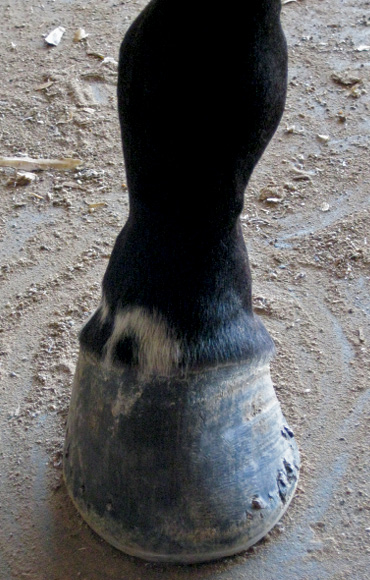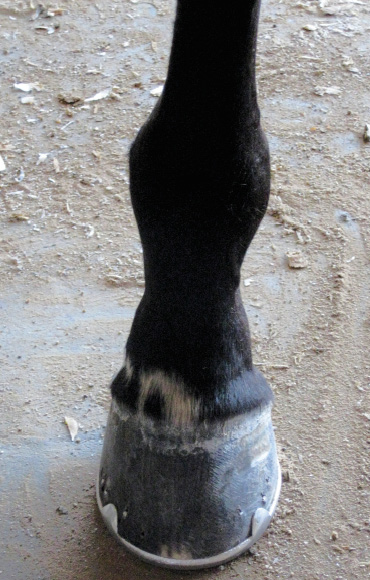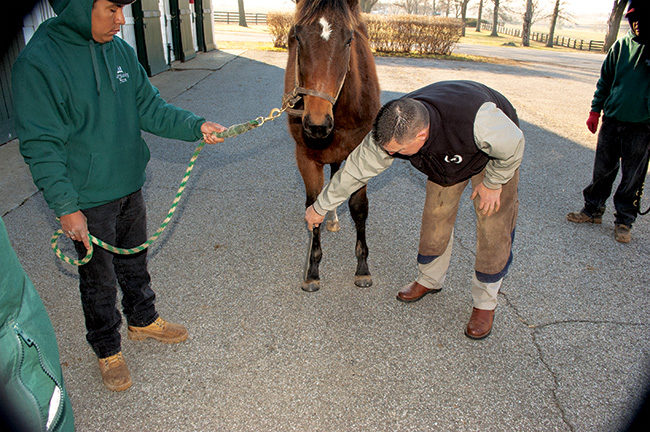Horses aren’t made from a perfect mold. So how do you trim and shoe the “imperfect” horse, the horse with conformation faults? Does farriery affect conformation? Does conformation dictate farriery?
Let’s look at the art and science behind shoeing for conformation faults.
According to Adam’s and Stashak’s Lameness in Horses, 6th Edition, “Conformation refers to the physical appearance and outline of a horse as dictated primarily by bone and muscle structures.” The test goes on to say that conformation is not absolute, but relates to function.
Certain conformation faults such as offset knees or long pasterns have been shown, at least in racing Thoroughbreds, to increase the risk of injury. However, the science of the effect of conformation on performance and lameness is still developing. But, since limb rotation and angulation can affect hoof growth and shape through altered weight bearing and footfall, conformation issues often become a concern for farriers.
Conformation Vs. Balance
Andrew Parks, of the University of Georgia College of Veterinary Medicine, differentiates between conformation and balance in the hoof while acknowledging that the distinction is a bit artificial since, “if you pick up the foot, you’re looking at both at the same time.”
In the equine veterinarian’s mind, conformation in the distal limb is a static thing, the sum of all of the pieces, how the size, shape, and angles relate, primarily driven by skeletal structure. He uses balance, on the other hand, to describe the relationship between the hoof capsule, P3 and the ground.
Parks makes this distinction to help understand what can and cannot be changed in the mature horse through farriery.
“We try to change the conformation of young foals by shoeing, but once the growth plates are closed, there’s no changing conformation without major surgery,” says the International Equine Veterinarian Hall Of Fame member. “If you try to change conformation in skeletally mature animals, you risk causing more problems than you solve.”
Bone is meant to withstand forces such as compression to a certain degree. Altering the balance of forces on the bone can create injury. “If you try to change the conformation in an adult,” Parks says, “you’ll cause such compression on one side and stretching on the other that you’ll create problems.”
However, the horse’s conformation will affect hoof balance and thus the farriery needs of the horse. “Abnormal angulation will change weight bearing on the hoof,” Parks says. “Since weight bearing affects balance, there is a relationship between the bones and the shape of the hoof. If the skeleton causes distribution of weight across the ground surface of the foot to change, it will change the growth of the hoof capsule; such that one side will grow faster and the other slower.”
Distinguishing between conformation and balance can help give insight into what can or cannot be fixed, Parks says. However, the exact degree to which conformation affects balance in the adult horse, or to which farriery can change conformation in the growing horse, still is not determined.
Jeff Thomason, of the University of Guelph’s Ontario Veterinary College, is a researcher in equine biomechanics, yet the connection between conformation and the forces on the distal limb still eludes him.
“What we really don’t know at the moment is the link between the shape, what it does to the biomechanics and what the animal’s living tissue does to the biomechanics,” he says.
The adaptability of the horse’s body is one of the things working against scientific certainty. “The whole distal limb is designed to tolerate variability in the way it’s loaded,” Thomason says. “Otherwise it would break all the time. But because it tolerates such variability, it makes it hard for us to know the difference between affecting a good change and making it worse.”
He gives the example of a horse with a slightly off hoof-pastern-axis. “The horse operates with its toe as a long lever, so it makes sense to have the bones aligned, and aligned with the dorsal wall of the hoof. But does that mean that a horse with a slight break to any of those angles is going to go lame? No, it doesn’t.”
Bone adapts to the stresses placed upon it, thickening in areas of increased load, for instance. Thomason has spent much of his career looking for a similar phenomenon in the hoof.
“If we knew how the hoof was responding to changes in biomechanics, it would make therapeutic farriery much more predictive,” he says. “If you change the way the skeleton is loaded, the individual bones remodel and reshape to minimize injury. We don’t know that occurs in the hoof. In a lot of ways, I think it doesn’t. Studies to try to determine that have been inconclusive.”
This unknown, Thomason says, is what makes farriery at this point an art rather than a science. “What you are doing to the biomechanics, the bottom line is that we don’t know,” he says.
Keratin’s Influence
The keratin of the hoof capsule might be responsible for some of this unpredictability. While the response of bone to stress can be measured fairly easily, keratin’s elastic nature makes things less certain.
“If you take the keratin of the hoof wall and stretch it out, it will become 15% longer,” Thomason says. “It takes that much strain to actually break it. In practice, if I measure strain on the hoof, I’m getting strains of less than 1%. It still has 15 times that to go until it breaks.”
This “overbuilding” can be a boon for farriers, he says. “We can do a lot to it without fear of breaking it. We can try a lot of things that aren’t going to harm it.”
It is that trial and error that forms the basis for what Thomason and Parks both call the “art of farriery.” According to Thomason, an experienced farrier “has plenty of tools at hand to change it if they see a problem, but the link to what is actually happening to the biomechanics isn’t known.
“There is still not a whole lot of information as to what the farriers are doing when they make the changes. Right now, the predictive basis is ‘we’ve tried it 10 times before and it worked eight times so let’s try it.’ This works much of the time, but not with every animal. When it doesn’t work, that’s when the imagination and expertise of the farrier come in.”
Until the science catches up with shoeing, farriers turn to the art of experience and observation to evaluate and shoe the complex variety of horses. Different breeds and disciplines present different challenges, so let’s take a look into the minds of four of the artists shoeing the variety of performance horses present in the United States today.
Bringing The Hoof To Conformation
Tim Shannon is a Moreno Valley, Calif., farrier who shoes a hunter-jumper/eventer population made up mostly of Thoroughbreds. Shannon says he sees a lot of flat feet, low-heel horses and high-low conformation in addition to “some negative palmar angles on the hind end.”
One of the things experience has taught Shannon is to evaluate a horse’s conformation when it’s moving as well as standing flat. “With the conformation in the fetlocks, you have two different conformations — when the horse is standing and when the horse is flexing and moving. If we shoe for when the horse is standing and don’t look at when it’s moving, we’re missing a lot.”
Shannon focuses on the fetlock, noting that if, for instance, when it flexes, it flexes varus (to the inside), that deviation will affect how the horse lands.
Since X-rays aren’t always available, Shannon likes to pay attention to his landmarks, as well as how the horse lands. “When the leg is facing away from me, looking at which way the frog’s pointing tells me a lot about rotation.”
When the front foot lifts off the ground, Shannon pays attention to where the frog is pointing. Whether it’s pointing straight down or medially, for example, can tell him about deviations below the fetlock.
He prefers, when possible, to match the distance between the apex of the frog and the breakover between feet.
“I like that to be uniform,” he says, “because I think that’s what makes each digit move more efficiently.”
The even distance helps make each digit move with the same amount of effort, improving gait symmetry, Shannon says.
However, he believes it’s important to acknowledge the individuality of each digit and recognize that trying to make each foot match in appearance, or even in shoe size, might not be in the best interest of the horse.
When working with a horse and owner for the first time, Shannon tries to identify the horse’s conformation and explain it to the owner.
“Horses have a foot conformation just like a hip or neck, and those things don’t change,” he says. “My goal is to determine what the foot conformation is and bring the hoof to the conformation.” He wants to sort out the horse’s intrinsic conformation from distortions because of previous shoeing or trimming.
Shannon has his own take on the art of farriery. “When I trim, the art comes in the second trim,” he says. “I look at how the foot responds. The goal is a uniform wall, the walls are thickening up, the white lines are tightening up, the frog is thickening, and there is an increase in growth rate.”
Perfection Is Elusive
Jim Jimenez shoes Thoroughbred racehorses in Southern California. His philosophy on conformation is a simple one: “Don’t mess with what God gave them.” For Jimenez, handling conformation issues is a matter of accepting that no horse is perfect and dealing with existing structure.
“In racehorses, we run into issues that are less desirable,” says the El Segundo, Calif., farrier. “We’d rather have horses that are slightly over at the knee than back at the knee. Most people would tell you that they’d rather have a horse that turns out slightly than toes in.”

A horse’s left hind hoof, left, that has flared and was not properly dressed. Southern California farrier Jim Jimenez dresses the flare, right, balancing the hoof and leg and improves its alignment.

Since he doesn’t see horses until about 2 years of age, Jimenez focuses on what he can address rather than trying to change existing conformation.
“When I get a horse in, I like to stand them on mats and evaluate the conformation overall,” he says. “I’m interested in the bottom 3 to 4 inches, ground to coronary band, that I can take care of.”
While he believes true conformation problems need to be addressed in foal-hood — as early as 4 to 6 weeks of age — Jimenez feels the effect of conformation faults can be minimized by addressing the flares that result from uneven weight bearing and landing.
“The thing that I’m interested in that I think is under-addressed is flares,” he says. “Run a line from the center of the knee to the toe, if I see a flare and address it I can make the foot look more desirable, get the horse moving in a true direction and weight bearing more evenly.”
Jimenez is cautious about giving advice to other farriers. “If you’re not there, you can’t see it all.” He believes in managing existing issues without over-correcting, giving the example of a clubfoot with a dish.
“If a horse has a clubfoot, that’s what God gave it,” he says, pointing out that trimming isn’t going to change the existing condition. “But if you’re not floating the heel down, you’re letting it get worse. I don’t want to be over-aggressive, but don’t let it get additional heel because of me.”
Similarly, he says it’s important to watch the toe length on horses with dished feet. “Bring back the dish, it helps them breakover and be more sound.”
Ultimately, however, Jimenez stresses the experience of the farrier as a key factor in handling horses with problematic conformation. “It takes an experienced horseshoer to know what you can and can’t do.”
And, lest anyone get too caught up in wanting to “fix” conformation, Jimenez points out the one thing no human intervention can change.
“I’ve seen some horses with close to perfect conformation, and I can’t understand why I can outrun them. Heart and desire overcome conformation flaws, not work that I can do at age 2.”
Only The Young
Kentucky farrier Steve Stanley shoes a lot of Standardbred racehorses. Like Jimenez, he believes that conformation changes should only be attempted in the growing horse. “With young horses, foals and yearlings, you’re trimming to try to correct conformation issues,” he says. “After that point you’re trying to accommodate them.”
The Versailles, Ky., farrier is mindful that different bones stop growing at different points in the foal’s life. “With young foals you’re concerned about rotational and angular deformities and the timetable you have to correct them. In a fetlock with an angular deformity you have 90 days; in the knee you have about 24 months.
“The earlier you intervene, the better chance of success, especially with fetlocks. If you wait 60 days to start, I think you are already behind the 8-ball. Working closely with a veterinarian gives you surgical options that can be game changers.”
He points out that trimming the growing horse is a little like trying to tell the future where the farrier needs to envision how the horse’s entire body will develop.
“With these horses, I feel like trimming for conformation is somewhat looking forward,” Stanley says. “You’re trying to predict what the horse is going to look like and keep that in mind. If the chest is narrow, and the horse is toeing out, I wouldn’t try to fix that. Let the horse mature.”
Once the horse is grown, he says, trimming and shoeing are about
supporting the existing structure
rather than trying to change the limbs. He gave examples of some of the conformation issues he sees, how these faults can affect hoof growth or the horse’s way of going and how he approaches each.
“With horses that are back on the knee, I like to put on something called a ‘flip-flop’ or ‘flapper’ pad,” Stanley says. “You put a half shoe on the front; the heel area of the pad is entirely ground surface. It gives a bit of ease to horses that are back on their knees.
“Horses with offset knees crush the outside heel under that leg; you have an atrophied lateral heel. I’ll use a bar shoe or a circuit plate to try to support the heel that is being crushed. Horses with outwardly rotated knees (knee knockers) tend to fold their feet inward, so they can have interference.”
Stanley also points out that while problems might be more readily apparent in the front limbs, it’s important not to ignore the hind end. “You may shoe differently if a horse is straight through the hocks vs. if it’s sickle-hocked.”
For Stanley, trimming and shoeing for conformation depend on mind-set. “It depends on what is meant by fixing a problem. If they mean changing the conformation, they can try, but it’s not going to fix the problem. They have to try to recognize what the conformation is doing to the lower limb.
“In racehorses, if your shoeing supports the lower limb of the leg and allows for the inevitable changes that conformation will do to the hoof, then I think you’re doing the horse a favor,” he concludes.
Harmony Of Movement
In the Pacific Northwest, Shane Westman shoes a variety of horses, mainly those in the Western disciplines. Westman’s approach to conformation is simple: “Stay out of the horse’s way.”
The Bow, Wash., farrier sees a lot of conformational variations, many of which he believes are “due to over-correction earlier in life.” Westman notes that a focus on aesthetics might damage function. “With the stress of making the leg or foot look right, it causes more damage.”
He sees conformation issues in the foot that represent compensation for faults higher in the body. “I see a lot of Quarter Horses. With that large muscle mass up above, with that wide shoulder and wide hip, the horses tend to be base-narrow. I see a lot of pigeon-toe.”
However, Westman feels that it’s important to avoid trying to artificially straighten a deviation from ideal conformation. “I don’t shoe to make the leg straight, but so the horse travels straighter. If you over-correct, you cause ligament and structural problems.”
“My theory,” Westman says, “is that I want all the pieces to move in harmony. I don’t want to just try to make the horse look aesthetically pleasing.”
Westman is resistant to pressures from owners or trainers to try to shape the “ideal” foot. “I’ll say if you want a straight horse, you need to go buy yourself a straight horse.”
He cites a case in which outside pressure for better aesthetics adversely affected the horse. “I see a lot of high-low horses and had a horse with a clubfoot. We had it moving great with the clubfoot, but the trainer wanted it to look good, so I got fired. Two years later, the horse came back with mechanical laminitis in that foot because they were lowering it too much.”
He takes the same approach to every horse, starting with the basic trim. “I don’t deviate from what I believe to be balance. I want to align that bony column with the foot and then do what we need to do mechanically with appliances.”
But with appliances, he likes to keep it simple. “Less is more. I just want to support what the horse has.”








Post a comment
Report Abusive Comment